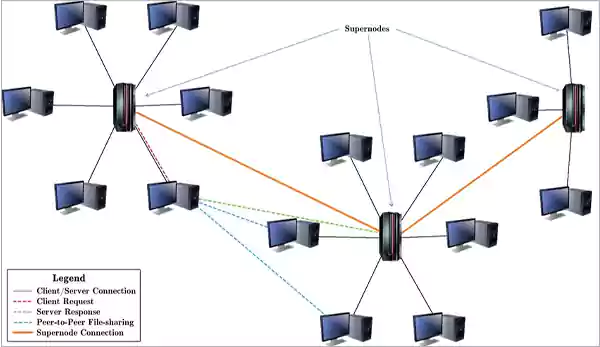Peer-to-Peer Technology in Bitcoins- Here are Things to Know

With the ever-growing market of cryptocurrency, it is still easy to say that Bitcoin has been on the list of top choices of investors since the start. Thanks to the introduction of blockchain technology, it has reached heights of fame by providing instant service to bitcoin buyers and sellers. And now there’s an introduction of Peer-to-Peer technology that has paved the way for Bitcoin to stay at the top, leading people to trade in bitcoins far more than before.
So, what is a peer-to-peer (P2P) network? A P2P network works as a decentralized mode of communication that works between two peers/nodes, interacting without central servers. Now, in a peer-to-peer (P2P) network, at first, a seeder sends a request to a leecher who works on it.
In a peer-to-peer (P2P) network, both the seeder and leecher play a significant role. This implies that the network, once built, may be utilized by the members to transfer and store data without the intervention of an intermediary.
How Do Peer-to-Peer (P2P) Networks Work?
A dispersed network of computers maintains a peer-to-peer paradigm. This is mainly because there are different copies of data in each node, which acts both as servers and clients. Each node uploads or downloads files to distribute them among other nodes upon sending and receiving requests. Instead of using a central server, these nodes save their data on their hard drives.

P2P networks are quicker and more efficient since each node has the same storage, transmitting, and receiving data. A P2P network, unlike conventional designs with a single point of failure, has a distributed topology that makes it highly resistant to cyberattacks.
Types of Peer-to-Peer (P2P) Networks
The architectural differences in P2P networks may be used to classify them. The following are the three primary categories.
Unstructured Peer-to-Peer (P2P) Networks

The nodes in an unstructured P2P network connect and interact at random. A P2P network is best suited for heavy-loaded tasks. For example, a social platform running on an unstructured P2P network may make good use of it, since members can join and leave the network at any time.
Structured Peer-to-Peer Networks

Structured networks, on the other hand, are set up in such a manner that nodes may effectively search for information even if it isn’t generally distributed. In most situations, these networks use a distributed hash table (DHT), which allows nodes to use hash functions to search for data. While structured networks can effectively route traffic, they are more centralized and have greater setup and maintenance costs.
Hybrid Peer-to-Peer (P2P) Network

A hybrid network integrates the peer-to-peer and client/server models on a single platform. A peer-to-peer (P2P) network uses index servers to store information about the location resources. However, in the case of a hybrid network, everything is controlled by a structured network. Compared to its contemporaries, this sort of network performs better since specific search queries demand centralized capabilities while benefiting from decentralized networks.
What Exactly is a Peer-to-Peer Cryptocurrency Exchange?
P2P cryptocurrency exchanges enable users to transact directly with one another to purchase or sell cryptocurrency. In contrast to centralized exchanges, where you must complete KYC to execute an order, most peer-to-peer exchanges enable you to send and receive cryptocurrencies without requiring you to provide proof of your identity.

Furthermore, unlike centralized exchanges, peer-to-peer exchanges do not have a single point of failure, as do centralized exchanges. When it comes to doing hassle-free crypto trading, you will need a highly secure and reliable platform. Going with the Official App can be a good option for crypto investors and traders.
Working Methodology of Peer-to-Peer Cryptocurrency Exchange Platforms

Diving deeper into the working methodology of peer-to-peer cryptocurrency exchange platforms, a crypto trader first has to register a new account in an exchange platform such as Binance. Completing this step requires no identity verification process, and it is just a valid email address and a strong password required for registration purposes. After registration, a user will browse through the many purchase and sell deals placed by other users on the site.
Payment methods, interest rates, and minimum and maximum purchase amounts vary from one offer to the next; each has its own set of rules. A buyer must first pick an offer and then contact the seller to complete the transaction. As a vendor, you may specify the acceptable payment method and any fees associated with it.
Merits and Demerits of Peer-to-Peer in Bitcoin4
P2P technology in Bitcoin offers a range of benefits. The primary benefit is the direct transfer of funds without interruption from a third party. Furthermore, users have complete control over their Bitcoin. Besides, the network is open 24 hours a day, 365 days a year, and the open-sourced nature of the network allows users to access it from any location around the world. Moreover, direct transactions are fast, with international transactions taking only 10 minutes and with minimal fees, allowing traders to get maximum profit from Bitcoin.
Everything in the world has two sides, positive and negative. Whether it be an invention, a discovery, or a newly found technology, they all come with specific advantages and disadvantages. But what could be the cons of using such an amazing technology in Bitcoin?
It cannot be asserted that the P2P network has a significant drawback. However, the same as Blockchain technology, peer-to-peer technology where the essential requirement for bitcoin legality is based on the internet, which can be a potential source of malicious cyber-attacks.
Final Words
So, these were some factors that you needed to know about a peer-to-peer (P2P) network. These networks are simple to set up, but they use a lot of CPU and memory since search requests are broadcast over the whole network. As a result, if just 5% of the machines have what you’re looking for, it might take a while.










